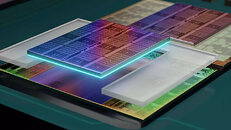
AMD Ryzen 7 5800X3D Geekbenched, About 9% Faster Than 5800X
Someone with access to an AMD Ryzen 7 5800X3D processor sample posted some of the first Geekbench 5 performance numbers for the chip, where it ends up 9% faster than the Ryzen 7 5800X, on average. AMD claimed that the 5800X3D is "the world's fastest gaming processor," with the 3D Vertical Cache (3D V-cache) technology offering gaming performance uplifts over the 5800X akin to a new generation, despite being based on the same "Zen 3" microarchitecture, and lower clock speeds. The Ryzen 7 5800X3D is shown posting scores of 1633 points 1T and 11250 points nT in one run; and 1637/11198 points in the other; when paired with 32 GB of dual-channel DDR4-3200 memory.
These are 9% faster than a typical 5800X score on this benchmark. AMD's own gaming performance claims see the 5800X3D score a performance uplift above 20% over the 5800X, closing the gap with the Intel Core i9-12900K. The 3D V-cache technology debuted earlier this week with the EPYC "Milan-X" processors, where the additional cache provides huge performance gains for applications with large data-sets. AMD isn't boasting too much about the multi-threaded productivity performance of the 5800X3D because this is ultimately an 8-core/16-thread processor that's bound to lose to the Ryzen 9 5900X/5950X, and the i9-12900K, on account of its lower core-count.
These are 9% faster than a typical 5800X score on this benchmark. AMD's own gaming performance claims see the 5800X3D score a performance uplift above 20% over the 5800X, closing the gap with the Intel Core i9-12900K. The 3D V-cache technology debuted earlier this week with the EPYC "Milan-X" processors, where the additional cache provides huge performance gains for applications with large data-sets. AMD isn't boasting too much about the multi-threaded productivity performance of the 5800X3D because this is ultimately an 8-core/16-thread processor that's bound to lose to the Ryzen 9 5900X/5950X, and the i9-12900K, on account of its lower core-count.



















































